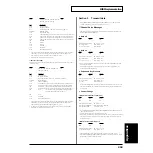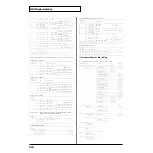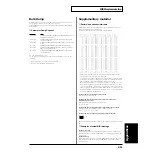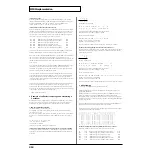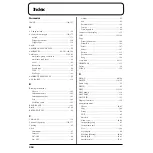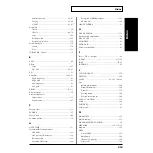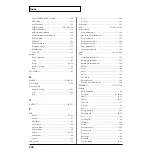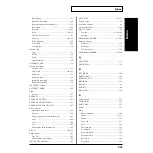
211
MIDI Implementation
Appendices
Bulk Dump
Bulk Dump allows you to transmit a large amount of data at once, and is convenient for
storing settings for the entire unit on a computer or sequencer.
For Bulk Dump Request, you must use the Address and Size listed in the following Bulk
Dump Request.
■
Parameter Dump Request
Address(H)
Size(H)
10 00 00 00
00 00 00 00 (ALL USER PATTERNS & ALL SONGS: dump request for
all user pattern and all song)
40 00 00 00
00 00 00 00 (SETUP: dump request for all setup except DEVICE ID
and LCD CONTRAST)
41 mm 00 00
00 00 00 00 (ONE DRUM KIT: single drum kit dump request specified
by “mm”)
41 7f
00 00
00 00 00 00 (ALL DRUM KITS: dump request for all drum kits)
44 nn 00 00
00 00 00 00 (ONE USER PERCUSSION SET: single user percussion set
dump request specified by “nn”)
44 7f
00 00
00 00 00 00 (ALL USER PERCUSSION SETS: dump request for all
user percussion sets)
mm = 00 - 3FH (Drum Kit No.1 - 64)
nn = 00 - 01H (User Percussion set No.1 - 2)Data of preset pattern (No.1 - 700) cannot be
transmitted.
*
Data of preset pattern (No.1 - 700) cannot be transmitted.
*
Make sure to set “00 00 00 00” for the data size.
Supplementary material
■
Decimal and Hexadecimal table
In MIDI documentation, data values and addresses/sizes of exclusive messages etc. are
expressed as hexadecimal values for each 7 bits.
The following table shows how these correspond to decimal numbers.
+----------------------------------------------------------+
| Dec. | Hex. || Dec. | Hex. || Dec. | Hex. || Dec. | Hex. |
|------+------++------+------++------+------++------+------|
| 0 | 00H || 32 | 20H || 64 | 40H || 96 | 60H |
| 1 | 01H || 33 | 21H || 65 | 41H || 97 | 61H |
| 2 | 02H || 34 | 22H || 66 | 42H || 98 | 62H |
| 3 | 03H || 35 | 23H || 67 | 43H || 99 | 63H |
| 4 | 04H || 36 | 24H || 68 | 44H || 100 | 64H |
| 5 | 05H || 37 | 25H || 69 | 45H || 101 | 65H |
| 6 | 06H || 38 | 26H || 70 | 46H || 102 | 66H |
| 7 | 07H || 39 | 27H || 71 | 47H || 103 | 67H |
| 8 | 08H || 40 | 28H || 72 | 48H || 104 | 68H |
| 9 | 09H || 41 | 29H || 73 | 49H || 105 | 69H |
| 10 | 0AH || 42 | 2AH || 74 | 4AH || 106 | 6AH |
| 11 | 0BH || 43 | 2BH || 75 | 4BH || 107 | 6BH |
| 12 | 0CH || 44 | 2CH || 76 | 4CH || 108 | 6CH |
| 13 | 0DH || 45 | 2DH || 77 | 4DH || 109 | 6DH |
| 14 | 0EH || 46 | 2EH || 78 | 4EH || 110 | 6EH |
| 15 | 0FH || 47 | 2FH || 79 | 4FH || 111 | 6FH |
| 16 | 10H || 48 | 30H || 80 | 50H || 112 | 70H |
| 17 | 11H || 49 | 31H || 81 | 51H || 113 | 71H |
| 18 | 12H || 50 | 32H || 82 | 52H || 114 | 72H |
| 19 | 13H || 51 | 33H || 83 | 53H || 115 | 73H |
| 20 | 14H || 52 | 34H || 84 | 54H || 116 | 74H |
| 21 | 15H || 53 | 35H || 85 | 55H || 117 | 75H |
| 22 | 16H || 54 | 36H || 86 | 56H || 118 | 76H |
| 23 | 17H || 55 | 37H || 87 | 57H || 119 | 77H |
| 24 | 18H || 56 | 38H || 88 | 58H || 120 | 78H |
| 25 | 19H || 57 | 39H || 89 | 59H || 121 | 79H |
| 26 | 1AH || 58 | 3AH || 90 | 5AH || 122 | 7AH |
| 27 | 1BH || 59 | 3BH || 91 | 5BH || 123 | 7BH |
| 28 | 1CH || 60 | 3CH || 92 | 5CH || 124 | 7CH |
| 29 | 1DH || 61 | 3DH || 93 | 5DH || 125 | 7DH |
| 30 | 1EH || 62 | 3EH || 94 | 5EH || 126 | 7EH |
| 31 | 1FH || 63 | 3FH || 95 | 5FH || 127 | 7FH |
+----------------------------------------------------------+
*
Decimal values such as MIDI channel, bank select, and program change are listed as
one(1) greater than the values given in the above table.
*
A 7-bit byte can express data in the range of 128 steps. For data where greater precision
is required, we must use two or more bytes. For example, two hexadecimal numbers aa
bbH expressing two 7-bit bytes would indicate a value of aa x 128 + bb.
*
In the case of values which have a +- sign, 00H = -64, 40H = +- 0, and 7FH = +63, so that
the decimal expression would be 64 less than the value given in the above chart. In the
case of two types, 00 00H = -8192, 40 00H = +- 0, and 7F 7FH = +8191. For example if aa
bbH were expressed as decimal, this would be aa bbH - 40 00H = aa x 128 + bb - 64 x 128.
*
Data marked “nibbled” is expressed in hexadecimal in 4-bit units. A value expressed as a
2-byte nibble 0a 0bH has the value of a x 16 + b.
<Example 1> What is the decimal expression of 5AH?
From the preceding table, 5AH = 90
<Example 2> What is the decimal expression of the value 12 34H given as
hexadecimal for each 7 bits?
From the preceding table, since 12H = 18 and 34H = 52
18 x 128 + 52 = 2356
<Example 3> What is the decimal expression of the nibbled value 0A 03 09 0D?
From the preceding table, since 0AH = 10, 03H = 3, 09H = 9, 0DH = 13
((10 x 16 + 3) x 16 + 9) x 16 + 13 = 41885
<Example 4> What is the nibbled expression of the decimal value 1258?
16) 1258
16) 78...10
16) 4...14
0... 4
Since from the preceding table, 00H = 0, 04H = 4, 14H = 0E, 10H = 0A, the answer is 00 04 0E
0A
■
Examples of actual MIDI message
<Example 1> 92 3E 5F
9n is the Note-on status, and n is the MIDI channel number. Since 2H = 2, 3EH = 62, and
5FH = 95, this is a Note-on message with MIDI CH = 3, note number 62 (note name is D4),
and velocity 95.
<Example 2> C9 20
CnH is the Program Change status, and n is the MIDI channel number. Since 9H = 9 and
20H = 32, this is a Program Change message with MIDI CH = 10, program number 33
(Drum Kit No.33).
Summary of Contents for V-Drums TD-8
Page 24: ...24 ...
Page 25: ...25 Quick Start Quick Start ...
Page 76: ...76 ...
Page 77: ...77 Advanced Use Advanced Use ...
Page 164: ...164 ...
Page 165: ...165 Appendices Appendices ...
Page 178: ...178 ...







